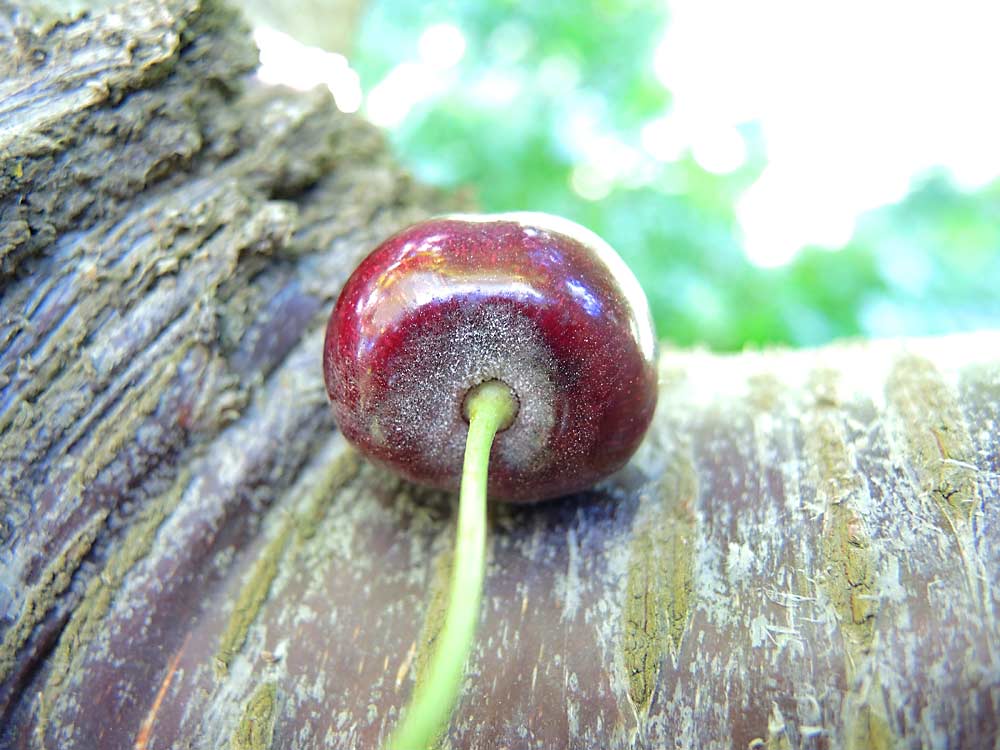
Cameron Peace, a horticulture professor at Washington State University, is searching for sources of genetic resistance to powdery mildew in sweet cherries. Behind him in his Pullman, Washington, laboratory are notes about other cherry DNA projects and his laboratory manager, Jack Klipfel. (TJ Mullinax/Good Fruit Grower)
Washington State University researcher Cameron Peace has determined reliable ways to screen for genetic factors that give sweet cherries resistance to powdery mildew. Now, he’s searching for others.
Peace, a WSU genetics professor, has just wrapped up one two-year project on screening for genetic resistance to powdery mildew and is embarking on another two-year slate of experiments to take the research further.
In total, the four years are funded by $146,000 in grants from the Washington Tree Fruit Research Commission, but Peace’s work is linked to projects involving researchers in other areas of the country, including RosBREED, a nationwide effort to develop better fruit through breeding practices.
Total funding for all the projects runs in the millions of dollars.
The second stage of Peace’s work also comes at a time of renewal for WSU’s cherry breeding program, centered at the Irrigated Agricultural Research and Extension Center in Prosser, Washington. Per McCord, one of Peace’s collaborators, recently took the reins of the cherry breeding program and has some of his own projects funded by the Research Commission.
In Peace’s first project in 2017 and 2018, he and his team established two reliable methods to screen cherry cultivars for resistance to powdery mildew, a fungal pathogen that attacks mid-season and late-season varieties such as Bing, Rainier and Sweetheart, some of the most popular cherries for consumers. One involves a leaf disk assay and the other is through DNA testing.
Peace and his team call powdery mildew an “insidious” pathogen that actually favors the dry climate of Central Washington, the largest sweet cherry producing region of the country. The fungus has been showing resistance to many of the synthetic fungicides growers have been using as a control.

A sweet cherry infected with powdery mildew, which Peace calls an “insidious” fungal pathogen. (Courtesy Claudia Probst/Washington State University)
Meanwhile, he determined that resistance to powdery mildew in fruit comes from the same genetics as resistance in the leaves; that is, resistant fruit tree leaves means resistant fruit. And all the known resistant or tolerant cultivars carry the same genetic factor, the Pmr1 gene, named by other researchers in 2000. These include Chelan, Moreau and several mildew-immune strains of Mazzard.
“It’s the same thing,” Peace said at the Northwest Cherry Research Review in November 2018 in Hood River, Oregon. “It’s good, it’s nice and simple as an answer. Genetically it’s nice and clean … but for breeding it’s a bit of a shame.”
Peace and fellow breeders usually want more than one gene — a genetic “pyramid” of multiple factors is preferred — to give rise to a desired character, especially when it comes to pathogen resistance, just in case the pathogen overcomes one resistance factor through chance mutation.
That’s where his second project will lead. Peace intends to test the long-term durability of the Pmr1 gene by inoculating the leaves of about 30 plants, including some sweet cherry cultivars, with powdery mildew at various infection levels over various periods of time.
If those cultivars with the Pmr1 factor develop disease, especially in a verifiable pattern over time, that would indicate the resistance source is not “durable.”
But if it is durable, the breeding program can heavily rely on Pmr1 resistance, crossing it into most or all future cultivar releases. That would thereby genetically solve the powdery mildew problem of the Northwest sweet cherry industry.
“If it’s not strong enough, alternative (genetic) factors need to be looked at,” said Alexandra Johnson, one of Peace’s graduate students who will perform much of the hands-on work during the new project.
Also, as part of his project, Peace and his team plan to search for those other genetic factors for powdery mildew resistance through the leaf disk assay and DNA testing. The genetics of tolerance observed in cultivars such as Regina and Venus are different than Pmr1, though not yet known.
For that reason, the project is “likely to succeed,” Johnson said. •
—by Ross Courtney






Leave A Comment